Yesterday’s live coverage of the Ukraine conflict can be found here. An archive of our liveblogs can be found here. For an overview and analysis of this developing story see our latest podcast.
Please help The Interpreter to continue providing this valuable information service by making a donation towards our costs.
View Ukraine: April, 2014 in a larger map
For links to individual updates click on the timestamps.
For the latest summary of evidence surrounding the shooting down of flight MH17 see our separate article: Evidence Review: Who Shot Down MH17?
A Russian human rights group, Memorial, has condemned statements made by Aleksandr Zakharchenko, the leader of the self-proclaimed ‘Donetsk People’s Republic,’ in which he suggests that his troops will simply execute Ukrainian POWs from now on, a statement which Memorial says is violation of the Geneva Convention. RFE/RL reports:
Speaking after a deadly Donetsk bus attack that he blamed on government forces, Zakharchenko said on January 23: “After this tragedy, I will give the order not to take any more prisoners. We don’t need swaps.”
“I don’t even want to hear about swapping captives anymore. If we swap, then one for one, by units,” Zakharchenko said.
“Respected Ukrainian mothers – you are sending your children to their deaths here!” he added.Memorial said the Geneva Conventions prohibit the issuance of orders not to leave anyone alive, making such threats, or conducting military actions on this basis.
— James Miller
Mashable’s Christopher Miller has a sensational report today about the unpublished annex to the Minsk agreement for a ceasefire between Kiev and Russian-backed forces:
A big reason why the deal failed was that no one could agree on who
would control the territory of the Donetsk airport. The rebels said it
was theirs, Kiev said it belonged to Ukraine, and so the two fought
pitched close-quarters battles over it for months, destroying it in the
process.
Only recently when a secret part of the Minsk deal was leaked to Ukrainian news outlet ZN.ua was it made clear that the deal actually handed the airport to the rebels.
An accompanying letter from Russian President Vladimir Putin to his
Ukrainian counterpart, Petro Poroshenko, included in the leak, asked
also that Kiev recognize territorial gains made by the rebels since the
ceasefire. The government has not done that and said it will not.
Conceding more ground to the separatists would be viewed by the
Ukrainian public as an indefensible surrender of sovereign land.
We’ve long heard of the “secret protocols” of the Minsk agreement. The original 12-point peace plan, at first published only in Russian and translated into English by The Interpreter, contained a point, passage of a Law of Ukraine “On Provisional Procedure for Local
Self-Government in Individual Districts of Donetsk and Lugansk Regions”
(Law on Special Status). This law was later indeed passed by the Verkhovna Rada, the Ukrainian parliament, but was not published for some time, and when it was, there was an open question:
What were the “individual districts of Donetsk and Lugansk Regions”? The agreement was never about all of Donetsk and Lugansk Regions, but only some parts. Which ones?
We asked Ukrainian officials repeatedly about this list since the Minsk accords were agreed upon but couldn’t get an answer. Essentially, if we knew the list, we would know which towns the two sides would continue to battle over. Perhaps the de facto answer was the list of areas where the Ukrainian “Anti-Terror Operation” (ATO) was still engaged. The battle locations of the months since the supposed “cease-fire” has enabled a reverse-engineering of that list.
The document published yesterday, January 24, by ZN.ua — if authentic — finally provides that answer. It is titled:
“Annex to the Memorandum of Enforcement of Points of the Protocol on the Results of Consultations among the Trilateral Contact Group Regarding Steps Aimed at Implementation of the Peace Plan of President of Ukraine P. Poroshenko and Initiatives of President of Russia V. Putin,” with a list titled “Line of Contact of Sides With Reference to Location.”
The list has towns and locations from Novokievka to Shyrokyne (Shirokina in Russian) — but it actually doesn’t contain “the Donetsk Airport” per se. The question about whether the Donetsk Airport should have been ceded by Kiev to the Russian-backed militants has therefore been hotly contested.
The Russians believe that the line of contact, once drawn through locations that are on the list, such as Pisky (to the northwest of the airport), would establish that the Donetsk Airport falls to the east of the line, that is within the territory claimed by the Russian-backed separatists.
Ukrainians have rejected that interpretation.
ZN.ua points out that the annex indicates the towns through which the line should be drawn, and the exact geographic coordinates, indeed putting the Donetsk Airport to the east of the line (translation by The Interpreter),
“And this is despite the fact that on the NSDC map, the airport is in the combat zone, but in numerous commentaries by Ukrainian officials, it is claimed that the Donetsk Airport is controlled by the Ukrainian side,” Tatyana Silina writes in an article for Zn.ua
Last Sunday, January 18, the Russian Foreign Ministry stated that the airport “in compliance with the Minsk agreements must be transferred to control of the militia.” Representatives of the Ukrainian Foreign Ministry and NSDC immediately replied: in the Minsk agreements, recorded in a protocol of September 5 and a Memorandum of September 19, 2014 did not contain a single word about the Donetsk Airport.
“Were they lying? No. But they weren’t telling the whole truth. In the Minsk documents, there really isn’t a word about the Donetsk Airport. But the fact that the airport should have gone to the separatists is proved by the numbers of the coordinates recorded in the Annex to the Memorandum. Likely this is because this document remained unpublished until now,” said Silina.
ZN.ua includes a map with a blow-up of the section where the Donetsk Airport is located:

Zn.ua also mapped all the points on the “secret annex” on Google maps in Silina’s article, titled “Topography of Blood”:
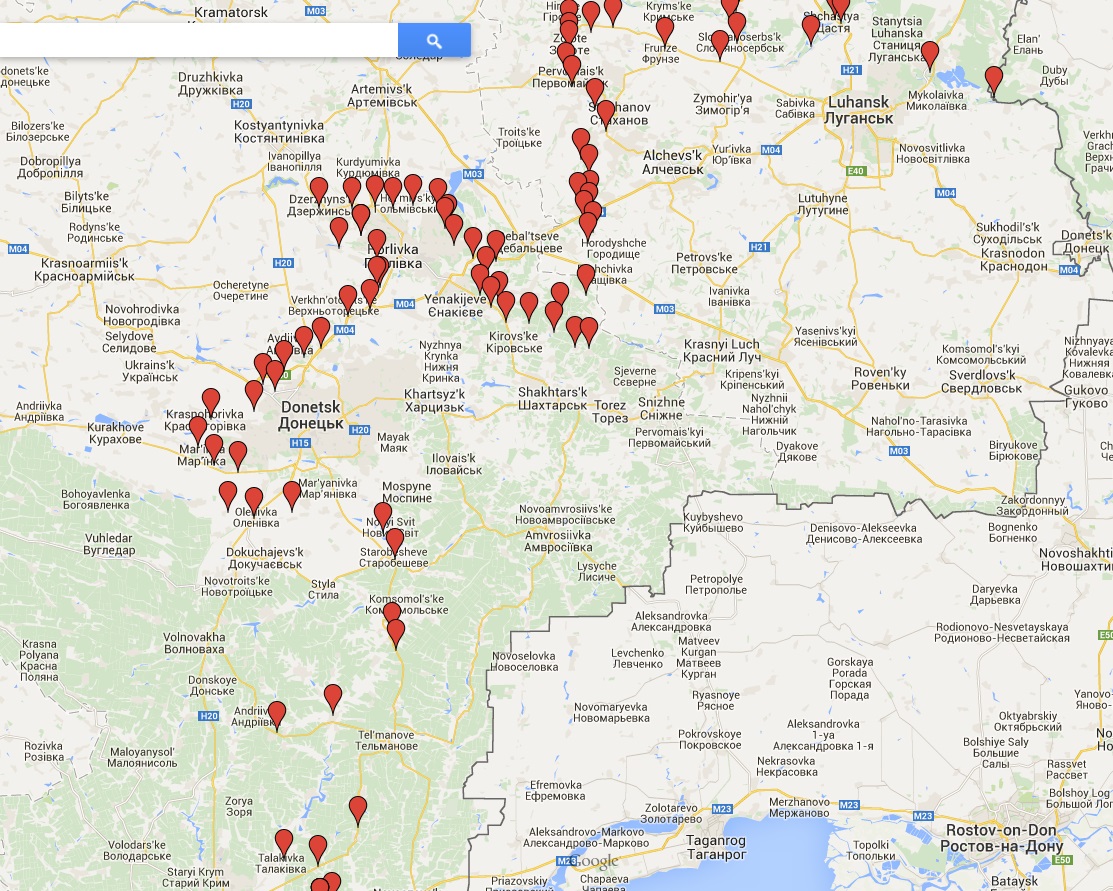
If we zoom in on the section of the map around the Donetsk Airport, we will see that in theory a line could be drawn connecting the dots of the towns indicated in the “secret annex” that would put the Donetsk Airport to the east of the line of contact:
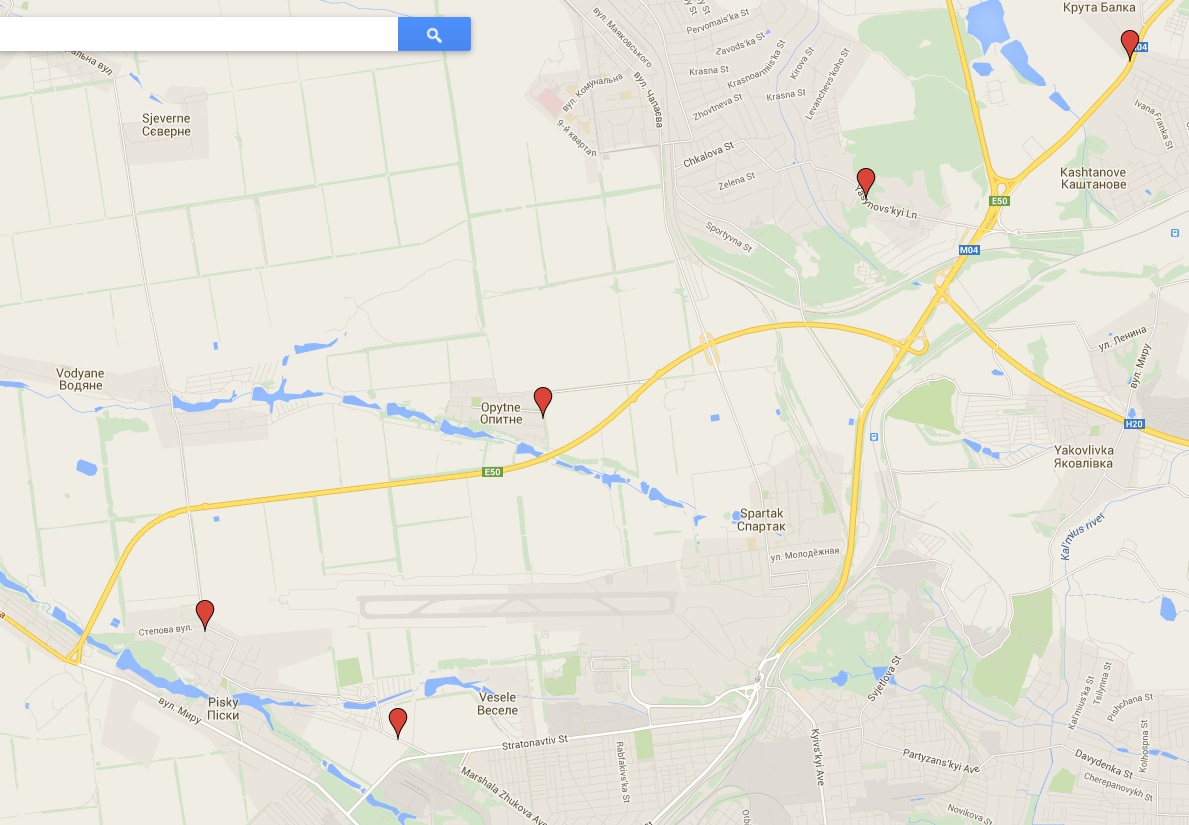
It’s worth noting that ZN.ua reported that many readers immediately objected to their implication of how the line would be connected. Some readers proposed an alternative reading that would divide the Donetsk Airport:

The point is that it was ambiguous enough and contested enough that Ukrainian soldiers were willing to fight and die for it.
Zn.ua emphasizes, however, that according to their sources, the issue wasn’t at all clear cut within the negotiation process that the Ukrainians should simply give up the airport (translated by The Interpreter):
As ZN.ua learned from a source, under the intent of the Minsk agreements, the airport should have gone to the separatists as a result of fulfillment of mutual obligations: the fighters should have transferred to Ukrainian control a number of populated areas. But they didn’t do that, much as, in fact they didn’t fulfill the rest of the points of the Minsk Memorandum. Accordingly, they weren’t handed the airport. The Ukrainian “Cyborgs” to this day continue a heroic defense. Nobody briefed them on the details of the Minsk agreements. “This is a complicated political issue,” not for the record, sources say on Bankovaya [the street where the presidential administration is located in Kiev–The Interpreter]. Of course it’s complicated! It was not advantageous to raise it before the parliamentary elections were over, and afterward, it was terrifying, because in that time, the “Cyborgs” had become national heroes.
It is clear on the map that Putin did not return to the line established in Minsk, since the proposals for the line of contact are even more to the west than the Minsk agreement. Moreover, according to our sources, the Russians and separatists refuse categorically from a demarcation of any lines. It is entirely obvious that they do not intend to fulfill the Minsk agreements — not individual points, nor as a whole. Hiding behind pretty phrases about peace, the Kremlin continues the offensive. Yesterday, Zakharchenko, the leader of the “DNR” managed from Moscow, said “We will advance to the borders of Donetsk Region. There will no longer be any attempts to talk about a ceasefire from our side.”
We could add that further evidence of that determination of the Russian-backed militants not to observe the letter or the spirit of the Minsk agreements (and their secret annex) came in the attack on Mariupol yesterday.
Mariupol is definitely to the west of the line of contact in the secret annex. But separatists fired Grad rockets from their position right at the line in Shyrokyne to kill 30 civilians, wound 70 more, and destroy many buildings in Mariupol.
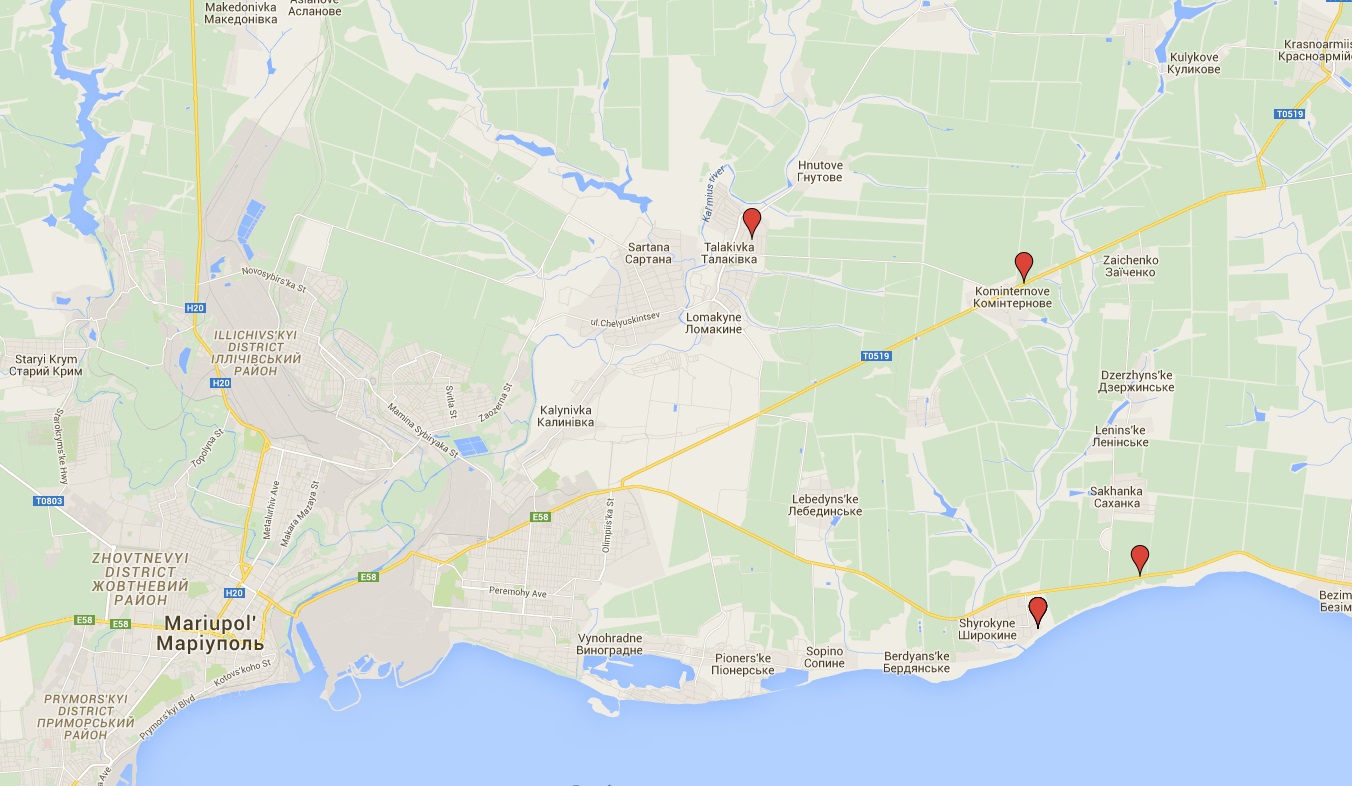
How will this end?
ZN.ua also obtained a copy of Putin’s January 15 letter to Poroshenko which supposedly contains a “peace plan,” but in fact it’s something different: a short letter suggesting that the two sides pull back “weapons with a caliber higher than 100mm, established by the Minsk Memorandum of September 19, 2014 to the factual line of contact according to the attached map.”
He attached a map, also published by ZN.ua, titled “Diagram for Withdrawal of Armaments Higher than 100mm in the Southeast of Ukraine” with a line sketched out strangely titled “Line of Contact of the Signs as of September 19, 2014 and January 13, 2015.”

Here is a blow-up of Sector B in Donetsk:
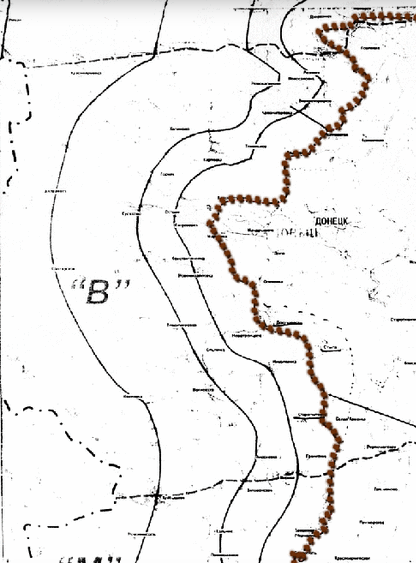
Why does ZN.ua characterize it as “strange”? As ZN.ua notes, starting in September, the Russian-backed separatists advanced westward and took over 550 square kilometers of Ukrainian territory, according to the Ukrainian government. Even during the Minsk talks, the separatists occupied 28 towns.
So now the “line of contact” of September 19 differs significantly from the line four months later, on the date Putin indicated, January 13. ZN.ua points out that “Putin’s appetites” should be compared not starting from the actual front line on September 19, but from the secret annex coordinates.
“Essentially, Putin is proposing to depart from the line fixed in that document and legitimize the ‘factual,’ that is, current line, which is absolutely not in Ukraine’s favor,” says ZN.ua.
As ZN.ua notes, US Ambassador Samantha Power made this point in a speech at the UN Security Council on January 21:
These are some of the reasons why the Russians’ most recent efforts
to blame Ukraine ring so hollow. On Thursday, [January 15] President Putin issued a
last-minute invitation to President Poroshenko to discuss a new
Russian-conceived so-called “peace plan” – a plan that would free Russia
from the commitment it made in Minsk to withdraw its fighters and
return control over the international border to Ukraine. The plan would
seek to legitimize territorial gains made by separatists since
September, as well as Russian personnel and military equipment on the
territory of Ukraine.
We’ve seen peace plans like this before in Abkhazia, South Ossetia,
and Transnistria. When President Poroshenko did not accept Putin’s
offer, Russia immediately launched a diplomatic and media blitz,
claiming it was proof that Ukraine is not interested in peace. Let us
pull the veil away from Putin’s peace plan, and call it for what it is: a
Russian occupation plan.
We need to implement the peace plans we already have, peace plans
Russia has signed and broken. If Russia is serious about peace, it
should follow through on Minsk, which it agreed to more than four months
ago. If Russia wants to end this conflict, the steps they must take are
the same as they were on September 5, 2014: remove all military
equipment and personnel from Ukraine; stop backing the separatists;
allow unimpeded OSCE monitoring and return control of Ukraine’s
international border to the Ukrainian government; and release all
hostages, including those being held in Russia, such as Ukrainian pilot
Nadiya Savchenko. We understand Ms. Savchenko has been on a hunger
strike for nearly a month to protest her detention, and is suffering
serious health problems. Yet Russia has taken none of the steps set out
in Minsk
The Law on Special Status of the Donbass, such as it was, was signed by President Petro Poroshenko in October 2014. In November, Poroshenko indicated that he might revoke the Law on Special Status of the Donbass
because the separatists reneged on their pledge and conducted a
separate, unrecognized election in some parts of Lugansk and Donetsk.
Even so, the law remains on the books as far as we know.
— Catherine A. Fitzpatrick
UA Today TV reports that despite the Russian-supported forces having launched offensives on three fronts, Ukrainian President Poroshenko said today that the Ukrainian military has “thwarted” the attacks:
“Terrorist groups planned to launch massive attacks beginning on 17 January. However, the effective and coordinated actions of the Ukrainian armed forces succeeded in preventing breakthroughs in each of the targeted directions,” Ukrainian President Petro Poroshenko said 25 January during an emergency session of the National Security and Defence Council.
This statement is curious because since January 17 Ukraine has lost control of Donetsk Airport, checkpoint 31 between Lugansk and Debaltseve, and is losing ground in many other locations: closer to Debaltseve, in Marinka near Donetsk, northwest of Donetsk Airport, and near Mariupol, just to name a few locations.
Reuters reports on statements made by Ukrainian military spokesperson Andriy Lysenko who says that four Ukrainian soldiers have been killed and another 17 injured in the last 24 hours:
Kiev officials said the offensive continued on Sunday along other areas in the front, which winds through two eastern provinces partially controlled by the separatists.
“Rebels are attacking the positions of anti-terrorist operation troops extremely intensively, using artillery, mortars, grenade launchers, tanks,” military spokesman Andriy Lysenko said in a televised briefing.
He said four Ukrainian servicemen had been killed and 17 injured in the past 24 hours and reported that rebel attacks on the town of Debaltseve, northeast of separatist-held Donetsk, had been particularly fierce.
“Because of constant shelling in the past few days, there are dead and injured among local residents. Around 60 homes have been destroyed or damaged,” he said without giving a figure for the number of casualties.
Lysenko reported that 3 had been killed and 50 wounded the previous day. Here’s today’s battle map, according to the National Security and Defense Council (NSDC):
As we reported earlier, Poroshenko is using Twitter to sound the alarm that “Russia Invaded Ukraine,” but at the same time he is downplaying military defeats, spinning them as victories. Why the contrast? One possibility – statements at the NSDC are primarily aimed at a domestic audience. Poroshenko may be trying to avoid panicking his populace. He may also be trying to save face and keep his popular support. Others have speculated that if Poroshenko announces that Ukraine is losing a war against Russia then he’ll be forced to mobilize the military, and if he believes that he cannot win a war against the Russian military, then he may also believe that a full-scale mobilization would spark more Russian interference.
Poroshenko is in an extremely difficult position, and it’s not clear what his strategy is at the moment.
— James Miller
U.S. Vice President Joe Biden spoke with Ukrainian President Petro Poroshenko yesterday. Here is the official summary of the conversation, posted by Biden’s office:
Vice President Joe Biden spoke today with Ukrainian President Petro Poroshenko about the situation in eastern Ukraine. The Vice President condemned the attacks and violence in eastern Ukraine initiated by Russia-backed separatists who have launched a military offensive against various cities and towns in the region. The Vice President and President Poroshenko expressed grave concern over Russia’s blatant disregard for its commitments under the September Minsk agreement and unilateral escalation of the conflict, and agreed to work with international partners to ensure that the costs continue to rise on Russia for its aggressive actions against Ukraine. The Vice President expressed his condolences for the tragic loss of life in Mariupol and elsewhere in eastern Ukraine.
The key words: the effort to ensure that “costs continue to rise” for Russia. In the past those “costs” have meant economic sanctions.
U.S. President Barack Obama has also made statements about Ukraine, as tweeted here by the U.S. Ambassador to Kiev, Geoffrey Pyatt:
Again, the key word here is “continuing” – as in not a change of course. The U.S. has thus far relied on sanctions to pressure Russia into changing course, so we are likely to see a deeper rounds of sanctions, possibly targeting Russia’s elite or entire government industries. There is even speculation that Russia could be banned from using the Society for Worldwide Interbank Financial Telecommunication (SWIFT), a system for transferring money between banks. The UK has been pressuring the European Union to ban Russia from using SWIFT since August, though thus far that has not happened.
Banning using SWIFT has previously been part of sanctions against Iran.
Ukraine’s President Petro Poroshenko has commented on sanctions, suggesting that they were “just the beginning,” but it’s not clear if he means that Ukraine is expected to push for more action or if he is actually expecting more action:
Estonian President Toomas Hendrik Ilves is not mincing any words, calling yesterday’s shelling in Mariupol that left 30+ civilians dead an “atrocity” and a “terrorist act.” Below is the official statement from his office:
“The terrorist attack by the Russian-supported separatists in Mariupol on Saturday morning, where dozens of civilians were killed by a rocket attack and even more were injured, is a despicable and brutal crime,” President Toomas Hendrik Ilves said, expressing condolences to the families of the victims and wishing the injured a quick recovery.
“The democratic world stands face to face with disgraceful evil and violence: separatists are attacking Ukrainian cities with the support of a permanent member of the UN Security Council,” the Estonian head of state declared. He once more called upon Russia to give up its support to the separatists and to use all its influence to ensure a halt to the violence, destruction and suffering of thousands of people in Southeast Ukraine.
“The extraordinary meeting of the European Union foreign ministers must affirm that we stand united and unwavering in our efforts to contain the aggressor and its supporters, which must also mean expansion of the visa sanction list and that we consider new economic sanctions,” President Ilves stressed.
“Let us abandon our illusions – we see the goal is to destroy the territorial integrity of a European state. Every new separatist attack only confirms their unwillingness to honour the ceasefire or to find a peaceful solution to the situation, because their goal and that of their supporters, is to expand military operations and continue to create new suffering,” the Estonian head of state said.
— James Miller
This is reminiscent of late August, when the Ukrainian government first acknowledged that what was happening in eastern Ukraine (in fact, near Mariupol) was a full-scale Russian invasion. That announcement was first made by the Ukrainian government via the Twitter account for Ukraine’s Ministry of Foreign Affairs.
Then, however, there were efforts in Kiev to walk back those claims and the Minsk “ceasefire” was negotiated and signed which at least partially froze the conflict. This time there seems to be more urgency as Ukraine is once again under heavy attack, but as it seems that there is no interest in any peace deal among Russian-supported forces.
— James Miller
At least 30 civilians were killed in Mariupol yesterday January 24 in a devastating attack from multiple Grad systems which is widely believed to have been fired by Russian-backed forces in nearby Shyrokyne. At least 70 were wounded.
The shelling of Mariupol has led to among the largest losses of life
in a single incident in the war. (The largest loss of life came on July 17, 2014
in the shooting down of MH17 with 298 killed; the second largest was
in the May 2, 2014 street clashes and Trade Union Building fire in
Odessa where a total of 48 people died.)
The leaders of the self-proclaimed “Donetsk People’s Republic” have not kept their story straight about the attacks on the city. First they boasted of an offensive on
Mariupol, then withdrew the claim when the condemnation of civilian deaths
came. Not all the media was pulled. The pro-Kremlin Komsomolskaya Pravda still shows the admitted offensive:
The blogger @DaJeyPetros has found a lot of the places of impact and mapped them:
While the Mariupol attacks represent a significant worsening of the war since the declared of the “ceasefire” in September 2014, the international community has not done much more than verbally condemn it — and even there, unity has been hard to achieve with Russia thwarting consensus.
A number of videos taken by citizens tell a lot of the story of Mariupol’s devastating hits.
A car parked in an apartment complex with its dashcam running shows the rockets flying over the buildings and starting fires on the ground.
The explosions can be seen ahead on the road in this driver’s dashcam
footage of rockets landing on the southern port city of Mariupol.
and said he saw the Grads hit and three people killed instantly.
He said they were saved by ducking behind two parked cars. When the hail of rockets was over (Grad means “hail” in Russian), he saw two rockets sticking out of the pavement.
From the rockets overhead and the rockets in the ground, he could confirm the direction, he said. Translation by The Interpreter:
“The flight of the rocket was from Novoazvosk. From Novoazovsk, I
can confirm that. I will go and get my daughter and she can confirm
this. So our forces [Ukrainians] didn’t shell on Mariupol. It is the
artillery of the Russian Federation forces.”
This video was taken by a fighter in the Azov Battalion. (WARNING: Graphic). It is among the most devastating footage of the war, because at least 4 people are seen torn apart and killed and at least 3 wounded, along with a huge swatch of destruction in an area of high-rise apartment buildings, stores, and schools.
The fighter moves along asking if anyone needs help carrying the wounded, and occasionally stops and then starts the filming again.
The city deployed 49 ambulances to the emergency but it was not
enough. So soldiers and civilians were picking up people in blankets and
bringing them to cars to drive them to overflowing hospitals.
A lot of the area he covers is in the neighborhood of the St. Nicholas Cathedral, as it can be seen in the background. He also drives by the Shchumy Kum store.

A man holds up Grad shrapnel:
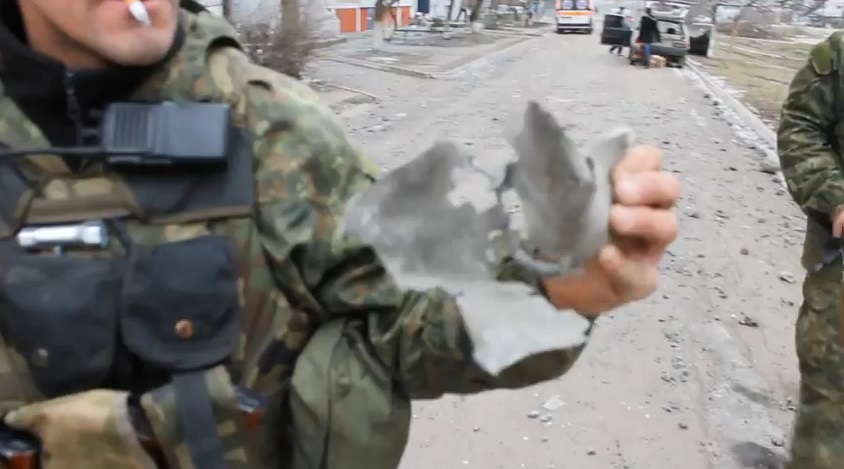
It’s also visible on the ground by stores.
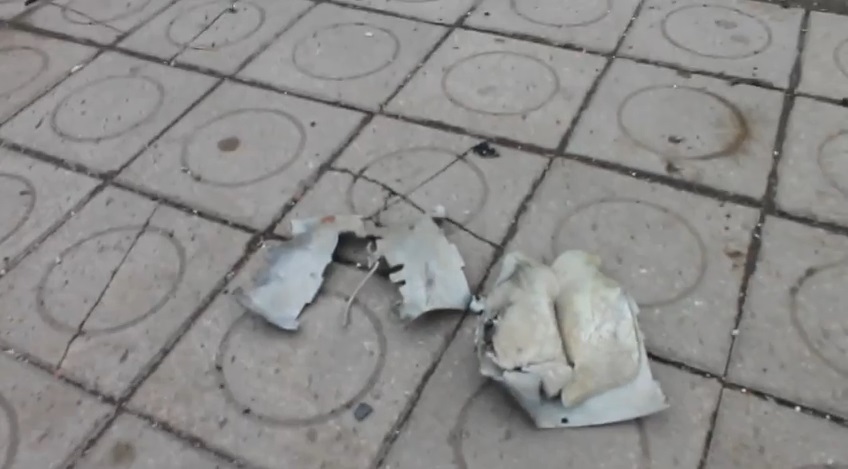
Then he goes over to examine a damaged school and two day care centers.
As we can see from the addresses of the day care centers and schools affected, they were all in the Kievskaya Street area in a neighborhood called Vostochny which means “east.”
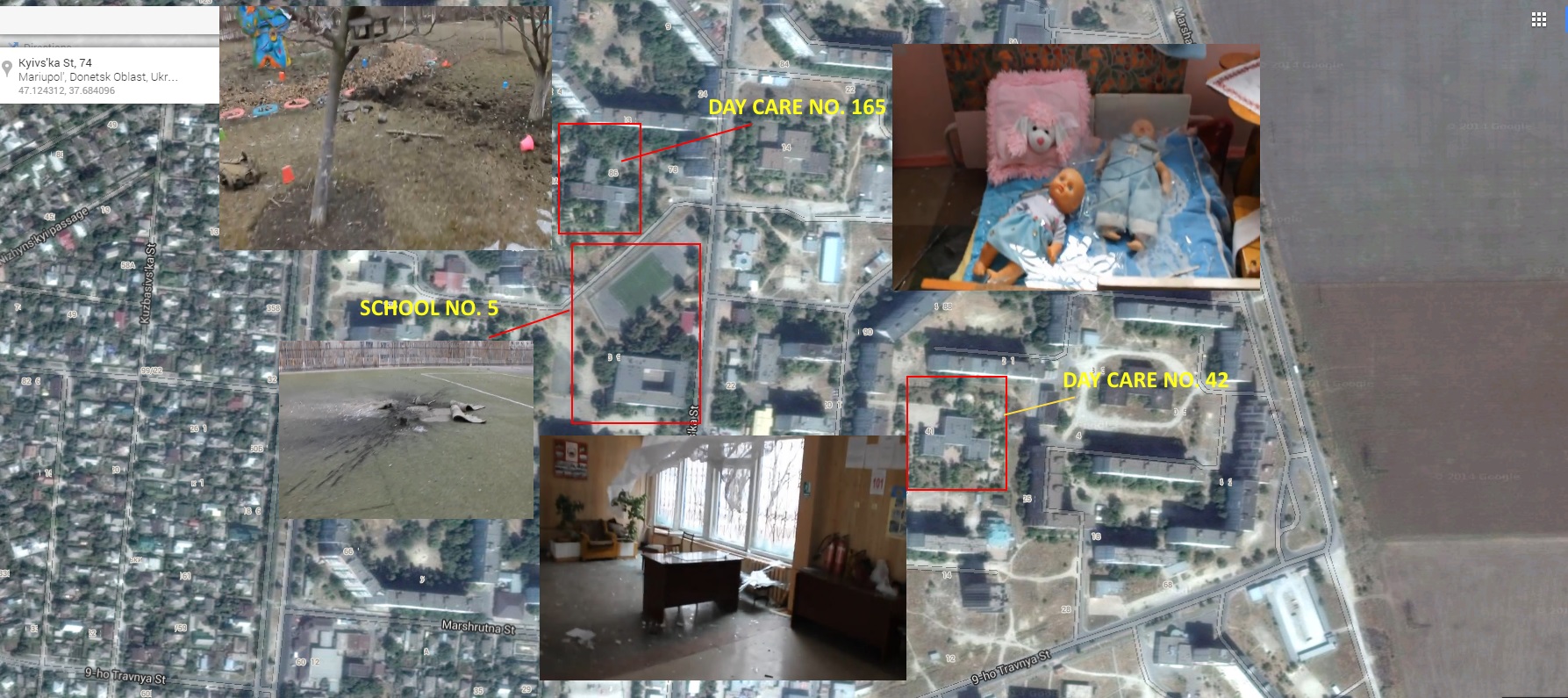
It was fortunate that the Grads hit on a Saturday, when there were no children in the schools or day care centers. No one was hurt.
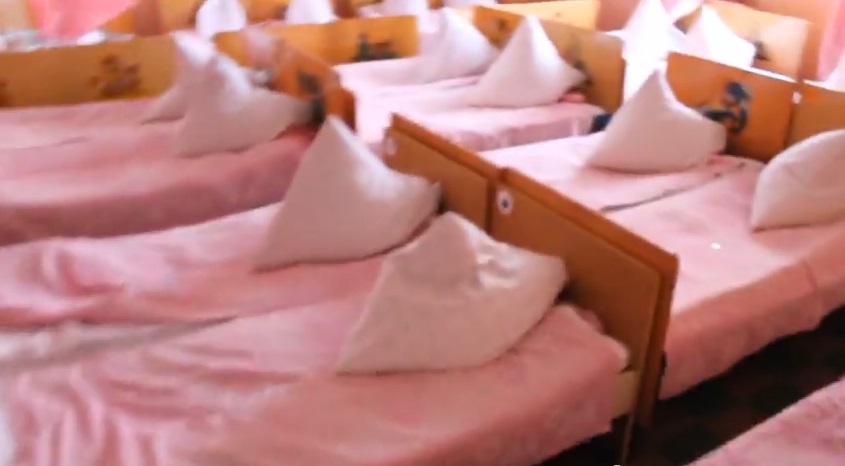
Glass is strewn everywhere, the windows are broken and walls fractured. A soldier is heard to say in the video that there is unexploded ordnance that needs to be defused and removed from the day care.
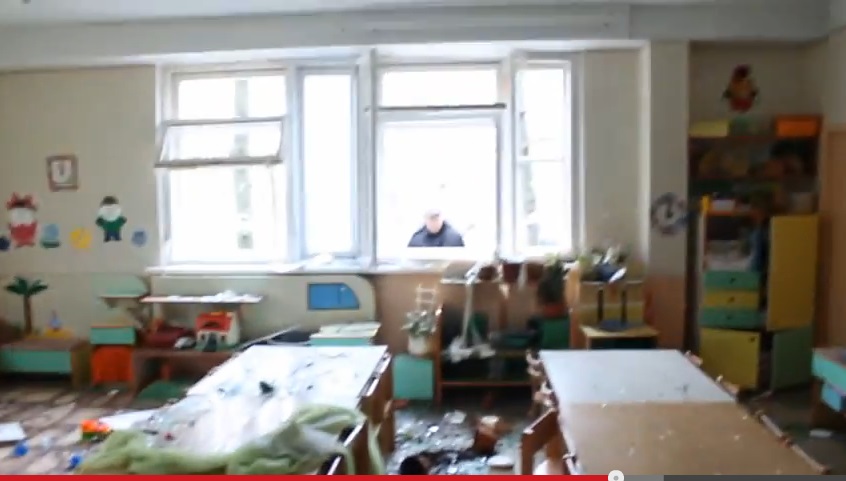
Some Grad rockets struck outside the day care center, in the playground.
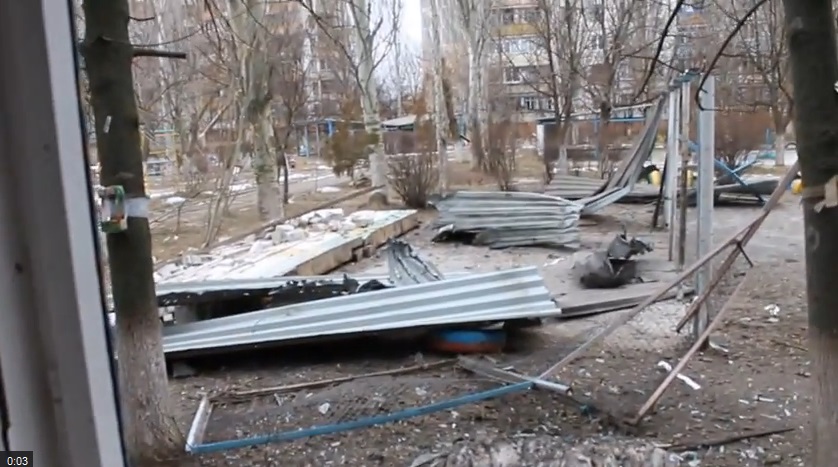
Burning stores are also captured in these images:
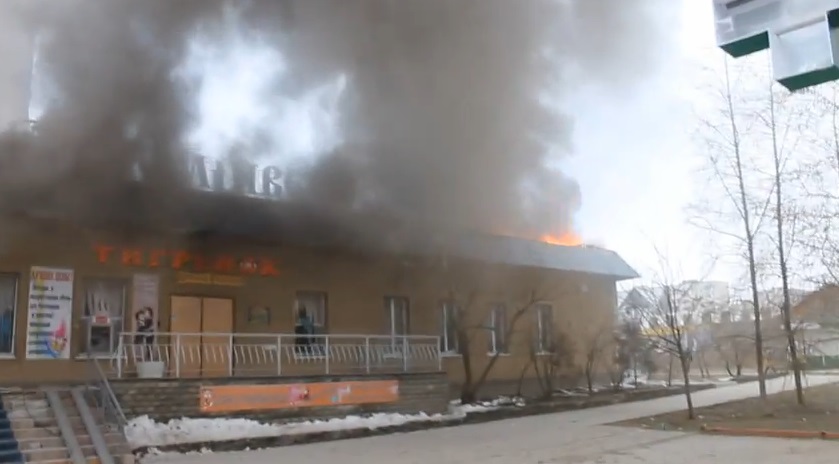
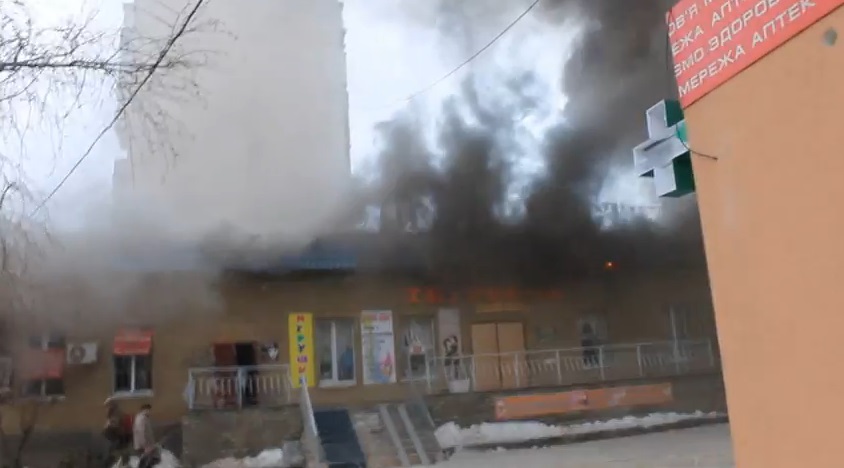
A children’s clothing and a toy store were among those closed when they were hit, so no one was hurt at those locations.
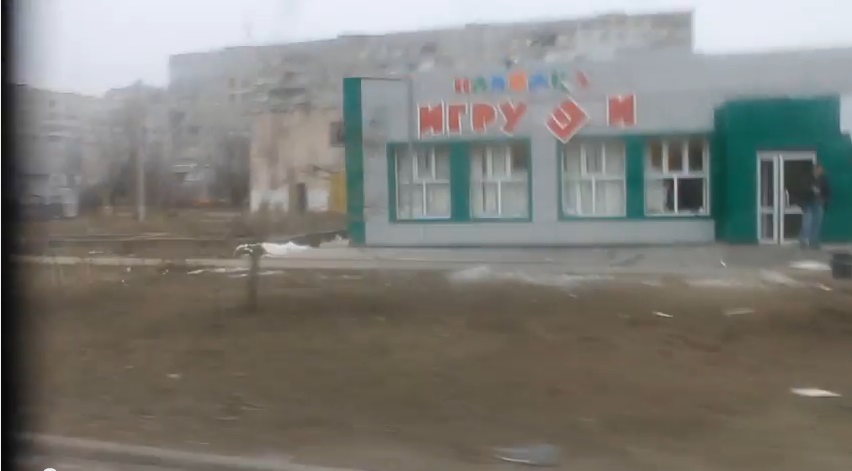
But others doing their Saturday shopping at the Kievsky and Denis markets, or just walking down the street, were not so lucky in the randomness of indiscriminate Grad rocket firing. Many of those killed were out in the open, but some were inside their apartments.
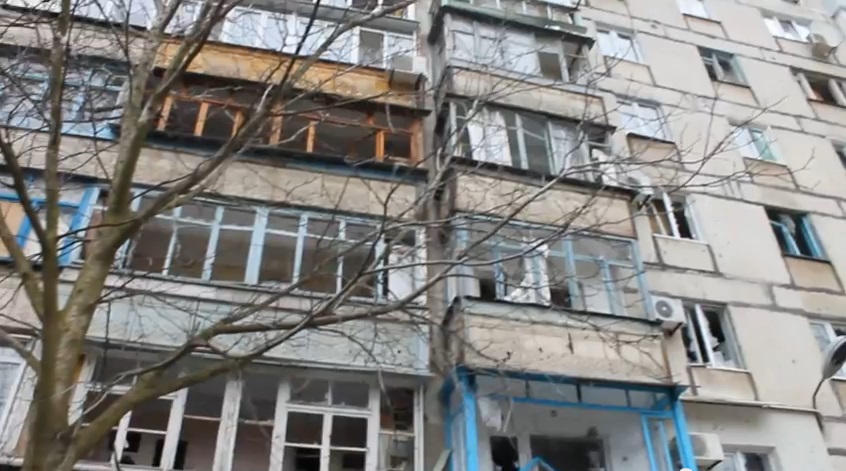
This person was killed by falling debris from an apartment building.
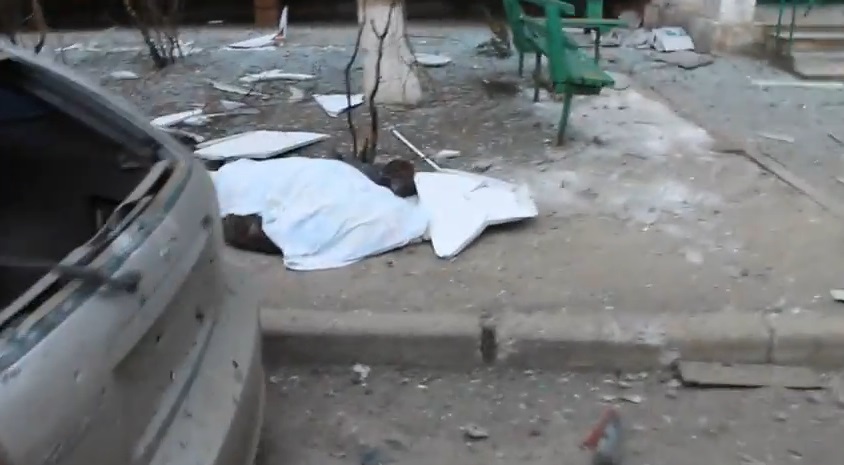
Numerous videos and photos were taken of broken Grad rockets lodged in pavement, enabling determination of the direction of the firing, like these ones near School No. 5:
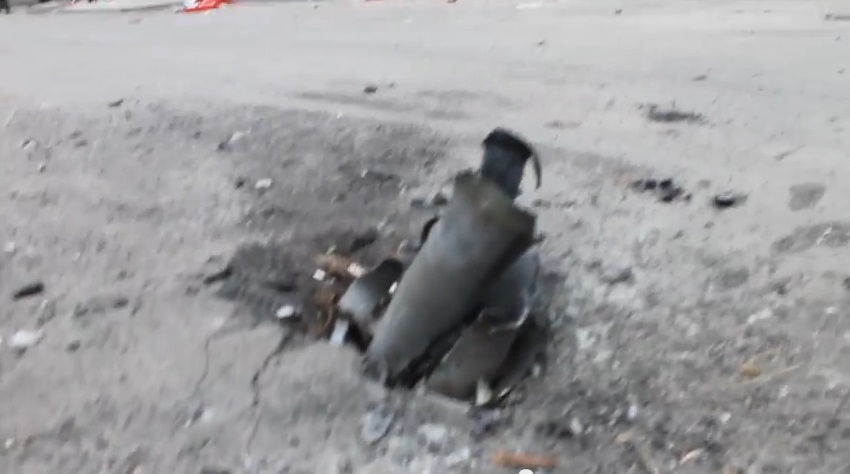
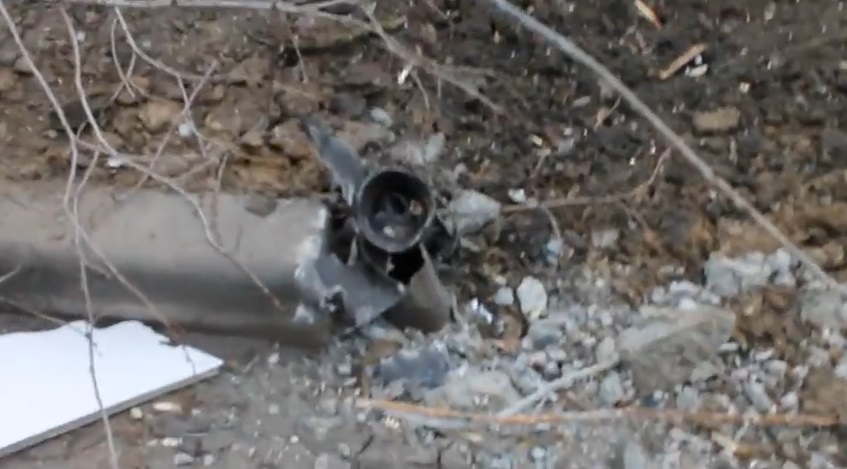
The blogger @enotis_ looked at the videos and evidence of Grad craters and damage he found in Mariupol and concluded the Grads came from the east:
Translation: The shelling of Mariupol from the direction of Novoazovsk. Photo proof.
Translation: In the video, it is clear visible how the rockets fall on Mariupol perpendicular to Olimpiyskaya St. We will place them on the map.
The video he is referring to is below, labelled “Mariupol Grad. Shelling of civilians by Russians troops.” It is located here on Yandex maps.
Another blogger Moris Buga has also mapped out a Grad impact:
— Catherine A. Fitzpatrick